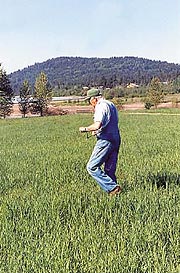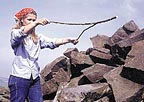
Prejudice of the driller toward the dowser may be more for economic reasons, but generally, prejudice toward dowsing usually is either one of two varieties - religious or scientific. Those with a religious bias tend to see dowsing as a tool of the devil. To those, I point to Matthew 7:16 in the Bible, "Ye shall know them by their fruits." And what could be more fruitful, as the driller knows, than providing good potable water to those in need? That's all that needs to be said about that.
Scientists typically argue that you can find water anywhere if you drill deep enough. Well, the driller knows this isn't exactly true (you might hit oil first). Besides, it's not much comfort to the client who is paying by the foot for the driller to say, "Don't worry, we'll hit water eventually." Furthermore, most dowsers do not just predict where to drill for greatest success in finding water. They also make predictions on three other parameters - depth, yield and quality. It's not considered a hit unless he or she is close on all four counts, well out of the realm of pure chance.
The scientist also argues that dowsing doesn't hold up under scientific testing. That's true. No argument there, but there are reasons for this. One is the limitations of the scientific method itself. Dowsing is not a phenomenon that can be studied in a laboratory setting like the vector forces of billiard balls. It is beyond the realm of Newtonian science and perhaps beyond that of Einsteinian physics. Secondly, dowsing works best where there is true need. It does not work for ego aggrandizement or for greed (no one yet has correctly dowsed lottery numbers). Furthermore, the source of the information the dowser channels is an intelligent source, not amenable to jumping through hoops for white-coated persons with an agenda to debunk. So for religious persons, scientists or drillers alike, who value an open mind and wish to learn more about dowsing, what follows is a comprehensive overview of this fruitful art.
Dowsing can be defined as "the search for information by means of a hand-held instrument and faculties beyond the five physical senses." There are two basic types of dowsing - tangible target and informational. However, whether one is searching for a physical object or substance, or for pure information, ultimately all dowsing is a search for information. It is accomplished by tapping into a higher and omniscient level of mind and spirit. The search is facilitated by four main types of dowsing instruments employed by modern dowsers - the Y-rod, L-rods, pendulum and bobber. By itself, the tool detects nothing, but merely functions as a read-out device. It is the body and the auric field, which is the detector and receptor. Ultimately, it is the goal of all dowsers to someday be able to dispense with the tools all together and receive information directly to consciousness.

Humans have dowsed all through the ages. Paintings on cave walls in the north of Africa dating back 8,000 years can be interpreted as a dowser holding a forked stick. Depictions on pottery and tomb walls show dowsing instruments such as staffs being used by ancient Egyptians and Etruscans. Coins, figurines and other artifacts depict dowsing in use throughout the Mediterranean and Mesopotamian worlds. A 4,000-year-old bas-relief with inscription at the dawn of historical times speaks of dowsing by the Emperor of China. Many passages in the Bible allude to dowsing. This art was brought to America by Europeans, who used it extensively for the location of both water and minerals.
Having been well established in the collective unconscious for many millennia before, one may likely experience today an immediate response from the dowsing instrument. However, it is important to emphasize that dowsing is 10 percent getting a reaction and 90 percent developing accuracy. The three keys to accuracy are attunement to the source, resonance with a clearly defined target and concentration on the right question. With practice and experience, one can expect over time to move through seven levels of dowsing proficiency: 1) location of physical objects on site, 2) detection of tangible targets at a distance and up to the horizon, 3) remote location of physical targets, 4) informational dowsing, 5) cooperation with nature, 6) co-creation with nature and 7) conscious union with creative forces.
Accuracy in dowsing also depends on following correct procedure, observing proper ethics and avoiding interference factors. Correct procedure begins with clearly establishing codes, so that the movements of the instrument can be correctly interpreted. It is of utmost importance to start any dowsing session by first identifying the source of your information and ensuring that it is from only the highest and purest level. Otherwise, your dowsing will be no better - or no safer - than using a Ouija board. One must establish that he or she has the permission to dowse a particular subject or object of search, and that one has the ability to do so. It is crucial to proceed with the proper attitude of faith, trust, respect, sincere motivation and true need. Ethics should be maintained so that dowsing is not abused for greed or selfishness, the compulsion for ego control and manipulation, or to intrude on another's privacy or free will. Interference factors to avoid can range from the purely physical, such as drinking too much coffee, to serious spiritual blockages, such as psychic invasion. Both strong mental bias and emotional attachment can also distort the answer.
How does dowsing work? There are as many theories as there are dowsers, but that which carries the most consensus is one which involves several levels of mind. A question is posed to the subconscious mind, which relays the question to the superconscious mind. The subconscious then conveys it to the conscious mind by means of the movements of the dowsing instrument. Studies of the brain wave frequencies of dowsers seem to support this hypothesis, in showing that dowsers are able to function on several frequencies at once (beta, alpha, theta and delta, corresponding to the waking state, reverie, dream sleep and deep sleep, respectively). Not even transcendental meditation could match this. Because of the nature of the subconscious, one must phrase questions in precisely literal terms. This is the real art of dowsing, to ask the right question. However, correct interpretation of the dowsing response also is very important.
The search for underground water is the best example of the great practicality of the dowsing art. Typically, dowsers search for living water, that is, water that comes from the depths of the earth, rising to form domes and extending out laterally in pressure-flowing veins. Such water is much purer, a more steady and reliable supply, and sometimes is found at shallower depths than the static ground water found in aquifers. A dowser also may find below the surface, oil, gas, minerals, archaeological sites, buried treasure or underground utilities.
One may more often use dowsing in daily life to locate objects on the surface of the ground. You may want to find your car in the parking lot, for example, or locate your lost car keys, a missing checkbook or a misplaced remote. Dowsers often are asked to find missing persons or pets, or help the police solve crimes. One can also dowse less tangible targets, such as in determining the health of a place by dowsing the geopathic or geovitalizing energies. Informational dowsing can be employed in making dietary decisions, such as choosing vitamins and supplements, for example. You may use it to determine the best course of action or the solution to a problem, whether it is in job hunting, looking for a house or apartment or seeking a healthy relationship. Another practical application is in gardening - dowsing soil conditions, amendment needs, time to plant, expected weather conditions, etc. The potential uses are limitless.
All dowsers vary as to what application they specialize in and excel at. They also differ in which of a great variety of dowsing instruments work best for them. What they all have in common, however, is the empowerment dowsing gives them. Its practice facilitates the connection to higher levels of mind and spirit, with simple, inexpensive and readily available tools. Trust in the direction and guidance of the source of all leads to a life lived more in alignment with one's own soul purpose, as well as with the universal plan. In other words, dowsing opens one to a greater reality, and the joy of feeling a valued part of the whole and the sense of fulfillment that comes with serving are the inevitable results.
ND
Report Abusive Comment